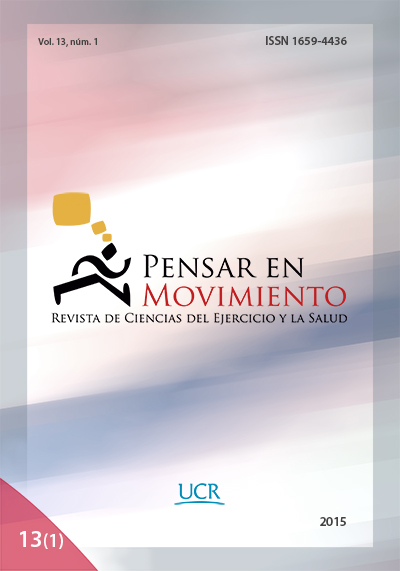Abstract
An effective antiperspirant is supposed to reduce sweat production by up to 50%, according to the manufacturers, but the scientific evidence in the literature is limited; possibly, the actual reduction may be so small that it may not be detected by conventional methods. The purpose of this study was to verify if the sweat patch method was able to detect the reduction in regional sweat loss that would be expected from using an antiperspirant. In addition, the magnitude of the effect was quantified. We verified the impact of an antiperspirant (condition A, skin treated with the product) on localized scapular sweat rate during 20 minutes of exercise at 78-80% HRmax, at 29.7 ± 0.5°C of ambient temperature and 54 ± 3.4% relative humidity, compared with a control condition (C, untreated skin). A statistically significant difference in scapular sweat rate was found between conditions: A = 14.6 ± 10.3 μL * min-1 and C = 19.2 ± 12.6 μL * min-1 (p = 0.001). This means that the participants secreted approximately 24% less sweat when using an antiperspirant, compared with the intact skin, as measured by the sweat patch method.
References
Adams, R. (1999). Revised physical activity readiness questionnaire. Canadian Family Physician, 45, 992. 995, 1004-1005. Extraído de la página web: http://www.ncbi.nlm.nih.gov/pmc/articles/PMC2328306/
Bain, A., Deren, T., & Jay, O. (2011). Describing individual variation in local sweating during exercise in a temperate environment. European Journal of Applied Physiology, 111(8), 1599-1607. Doi:10.1007/s00421-010-1788-9. Extraído de la página web: http://www.ncbi.nlm.nih.gov/pubmed/21190033
Burry, J., Evans, R., Rawlings, A., & Shiu, J. (2003). Effect of antiperspirants on whole body sweat rate and thermoregulation. International Journal of Cosmetic Science, 25(4), 189-192. Extraído de: http://www.ncbi.nlm.nih.gov/pubmed/18494900
Burton, A. C. (1934). A new technic for the measurement of average skin temperature over surfaces of the body and the changes of skin temperature during exercise. The Journal of Nutrition, 7(5), 481-496. Extraído de la página web: http://jn.nutrition.org/content/7/5/481.short
Gellis, R., Goslin, B., Olson, R., McDonald, A., Russi, G., & Moudgil, V. (2007). Longitudinal modeling on the relationship between age and maximal heart rate. Medicine and Science in Sport and Exercise, 39(5), 822-829. Doi:10.1097/mss.0b013e31803349c6 Extraído de la página web: http://europepmc.org/abstract/med/17468581
Havenith, G., Fogarty, A., Bartlett, R., Smith, C., & Venttenat, V. (2008). Male and female upper body sweat distribution during running measured with technical absorbents. European Journal of Applied Physiology, 104(2), 245-255. Doi: 10.1007/s00421-007-0636-z. Extraído de: http://link.springer.com/article/10.1007%2Fs00421-007-0636-z
Marfell-Jones, M., Olds, T., Stewart, A., & Carter, L. (2006). International standards for anthropometric assessment / Normas internacionales para la evaluación antropométrica. ISAK: Potchefstroom, South Africa. Extraído de la página web http://www.isakonline.com/publications
Maughan, R., Merson, S., Broad, N., & Shirreffs, S. (2004). Fluid and electrolyte intake and loss in elite soccer players during training. International Journal of Sport Nutrition and Exercise Metabolism, 14(3), 333-346. Extraído de la página web: http://www.coachingireland.com/files/fluid.pdf
Oppliger, R., & Bartok, C. (2002). Hydration Testing of Athletes. Sports Medicine, 32(15), 959-971. Extraído de la página web: http://www.ncbi.nlm.nih.gov/pubmed/12457417
Phillips, M., & McAllon, M. (2008). A sweat-patch test for alcohol consumption: Evaluation in continuous and episodic drinkers. Alcoholism Clinical & Experimental Research, 4(4), 391-395. Extraído de la página web:
http://www.ncbi.nlm.nih.gov/pubmed/7004238
Reynolds, K., Darrigrand, A., Roberts, D., Knapik, J., Pollard, J., Duplantis, K., & Jones, B. (1995). Effects of antiperspirant with emollients on foot-sweat accumulation and blister formation while walking in the heat. Journal of the American Academy of Dermatology, 33(4), 626-630. Doi: 10.1016/0190-9622(95)91283-5. Extraído de la página web:
http://www.jaad.org/article/0190-9622(95)91283-5/abstract
Schmidt-Rose, T., Lehmbeck, F., Bürger, A., Windisch, B., Keyhani, R., & Max, H. (2013). Efficient sweat reduction of three different antiperspirant application forms during stress-induced sweating. International Journal of Cosmetic Science, 35, 622-631. Extraído de la página web: http://www.ncbi.nlm.nih.gov/pubmed/23906286
Shirreffs, S., Aragón-Vargas, L., Chamorro, M., Maughan, R., Serratosa, L., & Zachwieja, J. (2005). The Sweating Response of Elite Professional Soccer Players to Training in the Heat. International Journal of Sports Medicine, 26(2), 90-95. Extraído de: http://www.researchgate.net/publication/8008087_The_sweat
ing_response_of_elite_professional_soccer_players_to_training
_in_the_heat
Smith, C., & Havenith, G. (2011). Body mapping of sweating patterns in male athletes in mild exercise-induced hyperthermia. European Journal of Applied Physiology, 111(7), 1391-1404. Extraído de: http://www.medscape.com/viewarticle/775404







